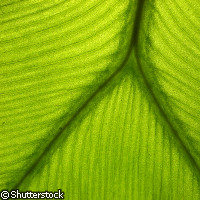Research uncovers evidence for an unorthodox theory of cell evolution
Researchers in the UK have discovered that the mechanism used by ancient bacteria to coordinate their responses to environmental change could also explain how plants and algae control photosynthesis, the process by which plants convert sunlight into energy. The study, published in the Proceedings of the Royal Society: B, provides evidence for an interesting theory of cell evolution that was first proposed in 1993. Cyanobacteria (blue-green algae) gain their energy through photosynthesis. They react in diverse ways to changes in the environment via a kind of signal-transduction system with two components: a sensor and a regulator. But while this two-component system is seemingly a feature of bacteria, evidence shows that it has persisted in plants and algae, and is also used by them to send signals that control the process of photosynthesis. Two-component systems can be seen in chloroplasts, the structures in plant cells which are responsible for photosynthesis. According to the new research, two-component systems play a fundamental role in linking photosynthesis with gene expression, and determine how plants can adapt to changing environments. Dr Sujith Puthiyaveetil of Queen Mary's School of Biological and Chemical Sciences in the UK explained, 'We already know that two-component systems act as a type of on/off switch for genes in bacteria. But the survival of these bacterial-type on/off switches in chloroplasts suggests a new model for gene regulation in plants.' Professor John Allen added, 'To many, it will be [a] shock to learn that some messages are sent within plant cells (and probably animal cells) using the same telegraph system as the one found in 'primitive' bacteria. It would be like discovering Morse code in your computer network, or a wax cylinder at the heart of your new, shiny digital HiFi. To us, however, the discovery is exciting evidence for an unorthodox theory of cell evolution first published 16 years ago.' Chloroplasts, like mitochondria, are highly specialised structures found within cells. Both have their own functional genomes and a gene expression apparatus that is separate from that of the cell's nucleus. Chloroplast genes contain the information needed to make the proteins involved in photosynthesis. The two-component system appears to have survived as a way of sending signals within the chloroplasts of plants and algae: regulatory signals from one part of this system determine how genes are expressed by the chloroplasts, for example by dictating changes in the oxidative state of energy-transduction components. 'If chloroplasts and mitochondria were responsible for the acquisition of two-component systems by eukaryotes [animals, plants, fungi and algae],' the study reads, 'it is interesting to ask whether these organelles themselves retain the two-component systems from their bacterial ancestors. The answer for chloroplasts is now known. It is 'yes'.' The researchers propose that two-component systems link photosynthesis with gene expression. 'Genes are therefore retained in chloroplasts, providing the basis of cytoplasmic [extranuclear], non-Mendelian inheritance,' the authors said. (Extranuclear inheritance involves the transmission of genes that are found outside the nucleus; Mendelian inheritance refers to the principles of heredity as we generally think of them; these were set out in 1865 by Gregor Mendel.) 'Photosynthesis acts on chloroplast genes to provide a voice, and a timed response, in the dialogue that takes place between the chloroplast and the cell nucleus,' they added. 'The two-component systems in chloroplasts persist from ancestral cyanobacteria, and epitomise a signalling system that could never have been put 'on hold' in evolution,' the study concludes. The two-component systems common to chloroplasts and cyanobacteria, they write, 'are keys to understanding the link between photosynthesis and gene expression, and may also illuminate the consequences of this link for eukaryotic cell evolution.'
Countries
United Kingdom



